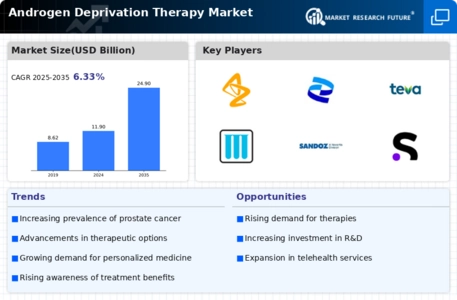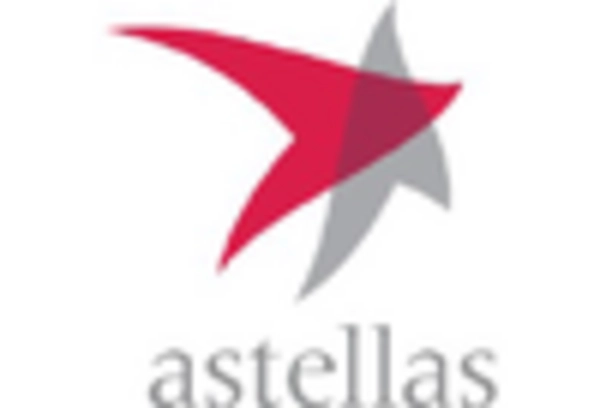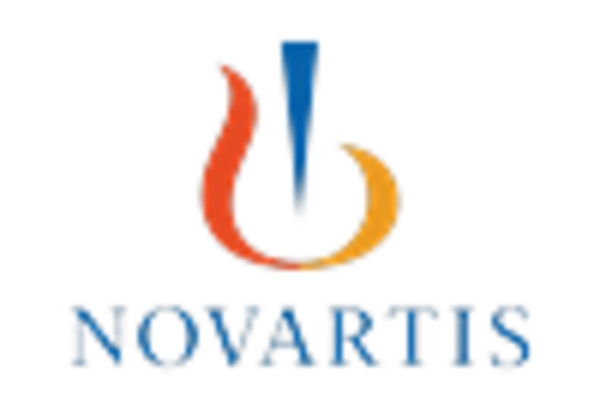Aging Population
The demographic shift towards an aging population is a significant factor influencing the Androgen Deprivation Therapy Market. As life expectancy increases, the incidence of age-related diseases, including prostate cancer, is also on the rise. Older men are at a higher risk for developing prostate cancer, which subsequently drives the demand for effective treatment options such as androgen deprivation therapies. Market projections indicate that the aging population will contribute to a substantial increase in the number of patients requiring these therapies in the coming years. Additionally, healthcare systems are adapting to accommodate the needs of this demographic, which may further enhance the accessibility and availability of androgen deprivation therapies. Consequently, the aging population is likely to play a crucial role in shaping the future landscape of the Androgen Deprivation Therapy Market.
Growing Awareness and Education
The increasing awareness and education surrounding prostate cancer and its treatment options are pivotal drivers for the Androgen Deprivation Therapy Market. Campaigns aimed at educating both healthcare professionals and patients about the benefits and availability of androgen deprivation therapies have gained momentum. This heightened awareness is likely to lead to earlier diagnosis and treatment initiation, thereby expanding the patient base for these therapies. Furthermore, educational initiatives have been instrumental in dispelling myths and misconceptions about prostate cancer, encouraging more individuals to seek medical advice. As a result, the demand for androgen deprivation therapies is expected to rise, contributing to the overall growth of the Androgen Deprivation Therapy Market. The emphasis on patient education may also enhance treatment adherence, further solidifying the market's expansion.
Rising Incidence of Prostate Cancer
The increasing prevalence of prostate cancer is a primary driver for the Androgen Deprivation Therapy Market. Statistics indicate that prostate cancer remains one of the most diagnosed cancers among men, with millions of new cases reported annually. This surge in incidence necessitates effective treatment options, leading to a heightened demand for androgen deprivation therapies. As healthcare systems strive to manage this growing patient population, the market for these therapies is expected to expand significantly. Furthermore, advancements in diagnostic techniques have improved early detection rates, which may contribute to an increase in treatment initiation. Consequently, the rising incidence of prostate cancer is likely to propel the Androgen Deprivation Therapy Market forward, as healthcare providers seek to implement effective management strategies for affected individuals.
Advancements in Treatment Modalities
Innovations in treatment modalities are reshaping the Androgen Deprivation Therapy Market. Recent developments in drug formulations and delivery mechanisms have enhanced the efficacy and safety profiles of androgen deprivation therapies. For instance, the introduction of novel agents and combination therapies has shown promising results in clinical trials, potentially leading to improved patient outcomes. Market data suggests that the introduction of these advanced therapies could lead to a substantial increase in market share for companies involved in the development of such treatments. Additionally, the ongoing research into personalized medicine may further refine treatment approaches, allowing for tailored therapies that align with individual patient needs. As these advancements continue to emerge, they are likely to drive growth within the Androgen Deprivation Therapy Market, attracting investment and fostering competition among pharmaceutical companies.
Regulatory Support and Reimbursement Policies
Supportive regulatory frameworks and favorable reimbursement policies are essential drivers for the Androgen Deprivation Therapy Market. Governments and health authorities are increasingly recognizing the importance of effective cancer treatments, leading to streamlined approval processes for new therapies. This regulatory support facilitates quicker access to innovative androgen deprivation therapies for patients. Moreover, favorable reimbursement policies enhance the affordability of these treatments, making them more accessible to a broader patient population. Market data indicates that regions with robust reimbursement frameworks tend to experience higher adoption rates of androgen deprivation therapies. As healthcare systems continue to evolve, the alignment of regulatory support and reimbursement strategies is likely to foster growth within the Androgen Deprivation Therapy Market, encouraging pharmaceutical companies to invest in research and development.


















Leave a Comment